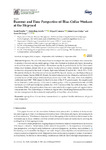Burnout and Time Perspective of Blue-Collar Workers at the Shipyard

Use este enlace para citar
http://hdl.handle.net/2183/26504Coleccións
- Investigación (FDER) [677]
Metadatos
Mostrar o rexistro completo do ítemTítulo
Burnout and Time Perspective of Blue-Collar Workers at the ShipyardData
2020Cita bibliográfica
Detaille, S.; Reig-Botella, A.; Clemente, M.; López-Golpe, J.; De Lange, A. Burnout and Time Perspective of Blue-Collar Workers at the Shipyard. Int. J. Environ. Res. Public Health 2020, 17, 6905.
Resumo
[Abstract] Background: The aim of the research was to investigate the association between time perspective in relation to burnout and successful ageing of blue-collar workers with physically highly demanding work and low autonomy. Shipyard blue-collar workers usually do predominantly manual labor versus white-collar workers, whose jobs do not usually involve physical work. Methods: 497 participants workers in a shipyard in the north of Spain. Ages were between 20 and 69 (M = 46.62, SD = 10.79). We used the Zimbardo Time Perspective Instrument (ZTPI), Spanish version, and the Maslach Burnout Inventory–General Survey (MBI-GS). Results: Emotional exhaustion factor obtained a coefficient of 0.97; cynicism factor of 0.83; and professional efficacy factor of p = 0.86. The mean of the three reliability coefficients was 0.887. With respect to the five factors of the ZTPI questionnaire: the negative past factor obtained a coefficient of p = 0.91; that of positive past p = 0.81; the present hedonistic of 0.878; the future of p = 0.83; and the fatalistic present of p = 0.90. The mean of the five coefficients, was p = 0.86. Conclusions: Within shipyard workers, burnout is associated with a negative past and negative future time perspective. This makes shipyard workers at a higher risk of developing burnout and this can have serious consequences for the sustainable employability of these blue-collar workers.
Palabras chave
Blue-collar workers
Ageing
Cross-sectional
Occupational health
Risk burnout
Shipyard
Ageing
Cross-sectional
Occupational health
Risk burnout
Shipyard
Versión do editor
Dereitos
Atribución 4.0
ISSN
1660-4601






